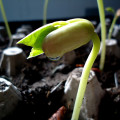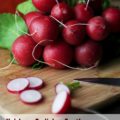 Have you heard about heirloom seeds and hybrid seeds? Maybe you’ve wondered what all the fuss was about. Well if you are living on a small homestead or backyard farm and want to be able to save seeds for next year’s garden, you want to start with heirloom plant varieties. This video will show you exactly why planting hybrid seeds is useless for self-sufficiency. [youtube]http://www.youtube.com/watch?v=dSFgK-njmtI[/youtube] These sunflowers were planted from a packet of seed that we were given. They were a hybrid variety, so I figured we’d plant them for the year and just see what happens. They were lovely, and we left a few heads standing for the cardinals who were attracted to the nutritious seeds. I love those gorgeous birds and decided to let them have a few. Well not only did the cardinals get their fair share, but they left a ton of seedlings that sprouted up as volunteers this year as well. Partly out of curiosity, and partly out of business while writing Backyard Farming on an Acre (More or Less), we left several of the seedlings to grow.
Have you heard about heirloom seeds and hybrid seeds? Maybe you’ve wondered what all the fuss was about. Well if you are living on a small homestead or backyard farm and want to be able to save seeds for next year’s garden, you want to start with heirloom plant varieties. This video will show you exactly why planting hybrid seeds is useless for self-sufficiency. [youtube]http://www.youtube.com/watch?v=dSFgK-njmtI[/youtube] These sunflowers were planted from a packet of seed that we were given. They were a hybrid variety, so I figured we’d plant them for the year and just see what happens. They were lovely, and we left a few heads standing for the cardinals who were attracted to the nutritious seeds. I love those gorgeous birds and decided to let them have a few. Well not only did the cardinals get their fair share, but they left a ton of seedlings that sprouted up as volunteers this year as well. Partly out of curiosity, and partly out of business while writing Backyard Farming on an Acre (More or Less), we left several of the seedlings to grow.  The variety is astounding. We had sunflowers that were dropping petals by the end of May and we had sunflowers just opening their flowers in July. Some were less than 2 feet tall and others were over 12 feet tall. Some had heads literally 2 feet in diameter and some had flowers with centers the size of a quarter. Fully half of them didn’t produce any seeds at all. Since then, we have planted heirloom seeds so we can save the seeds and have a viable crop year after year! Have you had an experience with hybrid or heirloom seeds?
The variety is astounding. We had sunflowers that were dropping petals by the end of May and we had sunflowers just opening their flowers in July. Some were less than 2 feet tall and others were over 12 feet tall. Some had heads literally 2 feet in diameter and some had flowers with centers the size of a quarter. Fully half of them didn’t produce any seeds at all. Since then, we have planted heirloom seeds so we can save the seeds and have a viable crop year after year! Have you had an experience with hybrid or heirloom seeds?










Sometimes hybrids come up great — they just don’t necessarily breed true to the parent plant. And sometimes hybrid varieties are sterile, too. It’s fun to experiment!
About half of these wound up inedible and about half put on seeds. A few were similar to parent plants but as you could see in the video – the variety was INCREDIBLE. And in terms of harvest in a timely manner and having enough produce to make it worth your time to process the food? Utterly worthless. Completely inconsistent. 🙂
Thanks for this demonstration! My husband and I are working and planning toward our homestead, and we have heard a lot about heirloom vs. hybrid, so I had head knowledge about it, but I had never seen such a striking example. Good to know!
It really was amazing to see the incredible difference in offspring this year. Of course next year we’ll mow down the volunteers and plant an heirloom variety instead so I can leave them standing for the birds with no qualms. I do love those cardinals…. 😉
Have you ever heard of the experiments of a monk named Mendel? His experiments with crossing various types of pea plants is the foundation of our understanding of genetics. If the genome has, say, 4 different genes that govern height, leaf size, flower size, seed viability, then you may have 16 different possibilities for plants resulting from these hybrid plants. Seems like this was the case for your experience here.
A “Hybrid” is when you take two different plant species or varieties and cross them. The hybrid seedlings carry genes dor both parents. How they mix and then express these genetic variations is part of the excitement of growing Hybrids.
I crossed a red Amaryllis with a white amaryllis. I got 12 matured plants that bloomed. One was red, one white and the other ten . . . none looked like another!
Fascinating isn’t it!?
This is interesting, but what it doesn’t take into consideration is that sunflowers are in the aster family, and so easily cross pollinate (think bees on sunflowers) with every other sunflower in the neighborhood. So even if you had heirloom seed, saving seed would probably not give you the same variety the next year. Species that don’t easily cross pollinate tend to be in the nightshade family (think peppers, tomatoes, eggplant, potato), beans and peas, and lettuce. Otherwise, you need space (in the case of corn, up to a mile) between your pure crop and the neighbors) to keep from outcrossing your stock. But sometimes, you get interesting variations by outcrossing, so it’s not all bad.
Jennifer – yes that’s very true. Some plants cross easier than others. But my main point is showing this was just that hybrid seeds can’t be relied on to produce offspring similar to the parents. They CAN (sometimes) produce offspring but you just don’t know what that offspring will be.
I definitely should discuss pollination and ways to prevent cross pollination (distance, bagging flowers, etc) in a separate post. Or if you wanted to guest post and discuss more about it that would be fabulous too! 🙂
This is so interesting! I’d love to read a follow up post on cross-polination.
You may also want to check out this flower identification app LikeThat Garden. It identifies flowers using your iPhone camera: https://itunes.apple.com/us/app/likethat-garden-flower-identification/id957861141?mt=8 I think you’d have fun with it too!